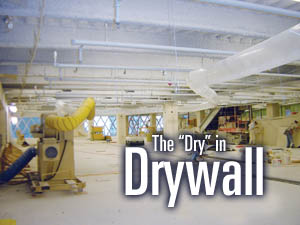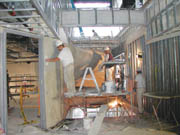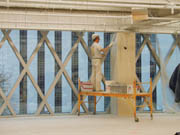projects requiring strict climate consistency during drywall installations.

As the drywall installation began at the Seattle Central Library, one component the job personnel didn't have to worry about was climate control. A process called "construction drying" works by using desiccant dehumidification instead of the permanent HVAC system or propane heaters. Permanent HVAC systems may control the environment to the comfort of the workers but they do not "dry out" construction-related moisture. According to one manufacturer, propane heaters have been proven to add moisture and contaminants to the air inside a building under construction.
The existing library was demolished in Sept. 2001, and a new one was rebuilt in the same location. The drywall installation required the bottom portion of the building be fitted with temporary closures, allowing contractors to heat and dehumidify the interior space as the fall months approached.
"We made an umbrella, erected the steel from the bottom up and then constructed the curtain wall from the top down," explains Bob Vincent, project manager, Hoffman Construction Co., of Seattle. "The first three floors are all concrete and we made a temporary roof on level three, which waterproofed levels two, one and zero. Then we went up with steel on the top up to level 11 and 12 (including the roof). Once we got the roof on we worked back down the curtain wall."

Dry idea
Once the project reached the drywall installation stage, a temporary closure was required to heat the interior space. This closure consisted of a full scaffold system acting as the curtain wall and a white tarp that was shrink wrapped over the scaffold, supplied by Safway Services Inc.In order to maintain a consistent temperature and humidity, the Construction Drying Services, provided by Munters, of Seattle, were installed.
"Basically, six heating and dehumidification units were brought in and big tubes run out of them around the building like ductwork," Vincent says. "Perforations are made in the tube allowing a specific amount of air to spread from the tube into the space. It makes it easy to get air where you want it, to channel it with these tubes."
The system served the library project well: Seattle experienced record rainfalls in October and the system kept the humidity out of the building.
Desiccant dehumidification has been around for decades but only in the latter part of the 1990s has it become more popular in the United States-in Europe, it's old news. Carl Munter, also responsible for inventing the first household refrigerator and Styrofoam, invented the process. With this system, a building's permanent HVAC system can sit out the construction process, reducing the opportunity for the permanent HVAC system to become contaminated by construction "debris."
"Permanent HVAC systems are not designed to dry out building materials during the construction process," explains Chris Cortinas, account manager for Munters Construction Drying. "The advantage of this system is it utilizes dry air to lower the vapor pressure inside the construction space. Usually, vapor pressure at the surface of building material is more than the vapor pressure in the material. This system draws the moisture out at a much more effective rate than direct-fired heat-which adds moisture to the air."

Dry walls
One reason this construction drying process is enjoying popularity in the United States is that it controls the ambient relative humidity inside the space. With concern about mold control, a 25 to 30 percent RH is typically preferred on a construction project in the northwest. By controlling the ambient RH, potential mold growth at the surface of the building material is prevented. The lowering of vapor pressure and simultaneously reducing moisture content enables joint compound dry time reduction to 11 or 12 hours. Dry air attracts moisture molecules from wet surfaces.According to Cortinas, the Northwest Wall and Ceiling Bureau requires a moisture content of 12 percent on wallboard during installation. When drywall is transported from the warehouse to the job site, it has a tendency to absorb moisture. With the construction drying system in place, once the drywall is delivered, it is immediately within a controlled environment that starts reducing moisture content in the board. By the time the installer begins to hang it, the moisture content is at the appropriate level, the joint compound drying time is less than 12 hours and the installation occurs within uniform conditions throughout the space.
"Using conventional environmental control methods, it can be difficult for a GC to meet the requirements set by board manufacturer and architect specs where it says joint treatment should not begin until certain uniform conditions are in place," Cortinas adds. "This system creates the dry air with a dehumidifier then uses inline blowers to distribute the dry air with a ‘lay flat' tube suspended like ductwork and custom perforated to fit each individual project's specific conditions. Every project is unique and requires a different setup."
Another advantage for drywall installations: A requirement of NWCB is that with a high-volume blower, there is a certain air change rate per hour requirement and moving the air around within the space and satisfying drying condition requirements.
"This greatly reduces the opportunity for joint compound failure, ridging, joint flashing or delayed shrinkage," says Cortinas. "There is no fluctuation in conditions."


